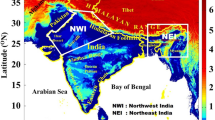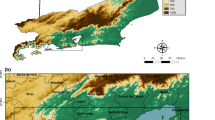Abstract
The decadal variation of lightning activity over Northeast India (NEI) from the year 2002 to 2011 is studied with the help of satellite-based lightning imaging sensor (LIS) data. An anomalous 56 % increase in lightning activity is observed in the year 2010 with respect to the previous years. To investigate the reason behind this increase, the LIS data are analyzed with several meteorological and cloud microphysical parameters. These parameters are convective sources of cloud ice, cloud top temperature, surface temperature, convective precipitation rate and total ice water content and convective available potential energy. On a synoptic scale, the period of anomalous lightning activity could be related to the development of an El Nino event at the middle of 2009 that broke down in the early months of the next year with a rapid transition to La Nina by August 2010. Analyses expose that El Nino Southern Oscillation might have diversely modified the local meteorological and cloud microphysical parameters. It comes out that this rapid transition from El Nino to La Nina condition could be the possible reason behind the dramatic increase in lightning activity, which was not previously documented over NEI.














Similar content being viewed by others
References
Adler RF, Markus MJ, Fenn DD, Szejwach G, Shenk WE (1983) Thunderstorm top structure observed by aircraft overflights with an infrared radiometer. J Clim Appl Meteor 22:579–593
Allan R, Lindesay J, Parker D (1996) El Nino Southern Oscillation and climate variability. CSIRO Publication, Collingwood
Arkin PA (1982) The relationship between inter annual variability in the 200 mb tropical wind field and the Southern Oscillation. Mon Weather Rev 110:1393–1404
Christian HJ, Blakeslee R, Boccippio DJ, Boeck WL, Buechler DE, Driscoll KT, Goodman SJ, Hall JM, Koshak WJ, Mach DM, Stewart MF (2003) Global frequency and distribution of lightning as observed from space by the optical transient detector. J Geophys Res 108:4005
Chronis TG, Goodman SJ, Cecil D, Buechler D, Robertson FJ, Pittman J (2008) Global lightning activity from the ENSO perspective. Geophys Res Lett 35:L19804. doi:10.1029/2008GL034321
Curtis S, Adler RF (2003) Evolution of El Nin˜o-precipitation relationships from satellite and gauges. J Geophys Res 108(D4):4153. doi:10.1029/2002JD002690
De BK, Pal M, De SS, Bera R, Adhikari SK, Guha A, Sarkar SK (2005) Studies on the integrated field intensity of ELF-VLF sferics at Tripura, India. Indian J Radio Space Phys 34(6):408–412
Ekman AML, Wang C, Wilson J, Strom J (2004) Explicit simulations of aerosol physics in a cloud-resolving model: a sensitivity study based on an observed convective cloud. Atmos Chem Phys 4:773–791
Goswami BB, Mukhopadhyay P, Mahanta R, Goswami BN (2010) Multiscale interaction with topography and extreme rainfall events in the north-east Indian region. J Geophys Res 115:1–12
Guha A, De BK (2009) Lightning electrical characteristics during tropical summer thunderstorm in north-east India. J Atmos Sol Terr Phys 71(12):1365–1373
Guha A, Banik T, De BK, Roy R, Choudhury A (2013) Characteristics of severe thunderstorms studied with the aid of VLF atmospherics over North–East India. J Earth Syst Sci 122:1013–1021
Hamid EY, Kawasaki ZI, Mardiana R (2001) Impact of the 1997–1998 El Nino event on lightning activity over Indonesia. Geophys Res Lett 28:147–150
Hoyos N, Escobar J, Restrepo JC, Arango AM, Ortiz JC (2013) Impact of the 2010–2011 La Niña phenomenon in Colombia, South America: the human toll of an extreme weather event. Appl Geogr 39:16–25. doi:10.1016/j.apgeog.2012.11.018
Hsu CF, Wallace JM (1976) The global distribution of the annual and semiannual cycle in precipitation. Mon Weather Rev 104:1093–1101
Huang R, Li W (1987) Influence of the heat source anomaly over the tropical western Pacific on the subtropical high over East Asia. Paper presented at international conference on the general circulation of East Asia. Nat Sci Found Of China (NSFC), Chengdu, China
Ju J, Slingo J (1995) The Asian summer monsoon and ENSO. Q J R Meteorol Soc 121:1133–1168
Kandalgaonkar SS, Tinmaker MIR, Kulkarni JR, Nath A, Kulkarni MK, Trimbake HK (2005) Spatio-temporal variability of lightning activity over the Indian region. J Geophys Res 110:11108. doi:10.1029/2004jd005631
Khain A, Rosenfeld D, Pokrovsky A (2004) Aerosol impact on the dynamics and microphysics of deep convective clouds. Q J R Meteorol Soc 131:2639–2663
Kumar RP, Kamra AK (2012) Variability of lightning activity in South/Southeast Asia during 1997–98 and 2002–03 El Nino/La Nina events. Atmos Res 118:84–102
Manohar GK, Kandalgaonkar SS, Tinmaker MIR (1999) Thunderstorm activity over India and the Indian southwest monsoon. J Geophys Res 104:4169–4188
Mc Phaden MJ (1999) Genesis and evolution of the 1997–1998 El Nino. Science 283:950–954
Molinie G, Jacobson AR (2004) CG Lightning and Cloud Top temperature over the contiguous United States. J Geophys Res 109:D13106. doi:10.1029/2003JD003593
Murugavel P, Pawar SD, Gopalakrishan V (2013) Climatology of lightning over Indian region and its relationship with convective available potential energy. Int J Climatol. doi:10.1002/joc.3901
Negri AJ (1982) Cloud top structure of tornadic storms on 10 April 1979 from rapid scan and stereo satellite observations. Bull Am Meteor Soc 63:1151–1159
Pawar SD, Murugavel P, Gopalakrishnan V (2010) Anomalous electric field changes and high flash rate beneath a thunderstorm in north east India. J Earth Syst Sci 119:617–625
Price C (1993) Global surface temperature and the atmospheric global circuit. Geophys Res Lett 20:1363–1366
Price C (2009) Will a drier climate result in more lightning? Atmos Res 91:479–484
Rasmussen EM, Wallace JM (1983) Meteorological aspects of the El Nino/southern oscillation. Science 222:1195–1202
Reeve N, Toumi R (1999) Lightning activity as an indicator of climate change. Q J R Meteorol Soc 125:893–903
Ronald MR (1986) Evalution of cloud- to ground lightning data from the western United States for the 1983–84 summer season. J Clim Appl Meteorol 25:785–799
Rosenfeld D (2000) Suppression of rain and snow by urban and industrial air pollution. Science 287:1793–1796
Satori G, Williams E, Lemperger I (2009) Variability of global lightning activity on the ENSO time scale. Atmos Res 91:500–509
Sherwood SC, Phillips VTJ, Wettlaufer JS (2006) Small ice crystals and the climatology of lightning. Geophys Res Lett 33:1–4
Ushio T, Heckman SJ, Boccippio DJ, Christian HJ, Kawasaki ZI (2001) A survey of thunderstorm flash rates compared to cloud top height using TRMM satellite data. J Geophys Res 106:89–95
Wang C (2005) ENSO, Atlantic climate variability and the Walker and Hadley circulations. In: The Hadley circulation. Past and Future. Kluwer, New York, pp 173–202
Williams E (1985) Large scale charge separation in thunderclouds. J Geophys Res 90:6013–6025
Williams E (1994) Global circuit response to seasonal variations in global surface air temperature. Mon Weather Rev 122:1917–1929
Williams E, Renno N (1993) An analysis of the conditional instability of the tropical atmosphere. Mon Weather Rev 121:26–31
Williams ER, Mushtak V, Rosenfeld D, Goodman S, Boccippio D (2005) Thermodynamic conditions favorable to superlative thunderstorm updraft, mixed phase microphysics and lightning flash rate. Atmos Res 76:288–306
Wolter K (1987) The Southern Oscillation in surface circulation and climate over the tropical Atlantic, eastern Pacific, and Indian Oceans as captured by cluster analysis. J Clim Appl Meteorol 26:540–558
Yoshida S, Morimoto T, Ushio T, Kawasaki Z (2007) ENSO and convective activities in Southeast Asia and western Pacific. Geophys Res Lett 34:L21806. doi:10.1029/2007GL030758
Yoshida S, Morimoto T, Ushio T, Kawasaki Z (2009) A fifth-power relationship for lightning activity from Tropical Rainfall Measuring Mission satellite observations. J Geophys Res 114:D09104. doi:10.1029/2008JD010370
Acknowledgments
The authors are thankful to Web site of Global Hydrology and Climate Center Lightning Research Team at National Aeronautics and Space Administration’s (NASA) Marshall Space Flight Center for providing the Lightning Imaging Sensor (LIS) data and Bureau of Meteorology, Australia for supplying the Southern Oscillation Index data. We are also thankful to Tropical Rainfall Measuring Mission (TRMM) Online Visualization and Analysis System (TOVAS), Moderate Resolution Image Spectrometer (MODIS) Terra satellite, Aura (Ozone Monitoring Instrument) OMI model, North American Land Data Assimilation System (NLDAS)_NOAH, North American Land Data Assimilation System (GLDAS)_NOAH, a member of the Giovanni Goddard Earth Sciences and information service center (GES-DISC) Distributed Active Archive Center (DAAC) Online Visualization and Analysis System) family for providing the other meteorological parameters such as rainfall, aerosol data at 550 nm, aerosol fine mode, total ice water content, surface temperature data. The work is funded by Govt. of India Department of Science and Technology—Fund for Improvement of Science &Technology infrastructure DST-FIST fund reference Ref. SR/FST/PSI-191/2014.
Author information
Authors and Affiliations
Corresponding author
Rights and permissions
About this article
Cite this article
Guha, A., Banik, T., Roy, R. et al. The effect of El Nino and La Nina on lightning activity: its relation with meteorological and cloud microphysical parameters. Nat Hazards 85, 403–424 (2017). https://doi.org/10.1007/s11069-016-2571-y
Received:
Accepted:
Published:
Issue Date:
DOI: https://doi.org/10.1007/s11069-016-2571-y




